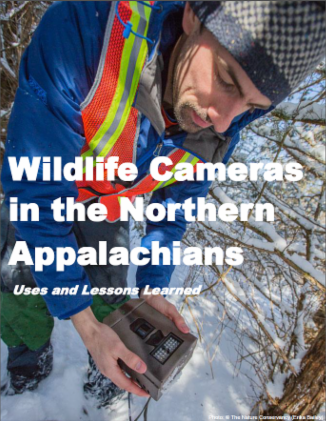|
|
|
Fall 2017 - In This Issue:
|
|
|
|
|
|
|
|
Photo credit: Carl Heilman I
I
|
|
| News from Staying Connected |
Dear SCI partners and friends,
If I had to choose one word to describe the past few months as SCI coordinator, that word would be inspired. Here are a few reasons why:
In September, the work group charged with implementing the New England Governors and Eastern Canadian Premiers Resolution on Ecological Connectivity convened for the first time, with a goal of understanding the best work happening across the region
-
from science to land management to transportation.
The SCI partnership figured prominently in this bi-national workshop and will guide actions going forward.
I had the opportunity to present
an overview of SCI and our work, and most of the
other presenter
s
were SCI partners.
Last month, at the Conference on Road Ecology and Climate Change Adaptation in Quebec City, SCI partners shar
ed best practices from across our region in science, community engagement, land use planning, and of course transportation
-
and SCI transportation agency partners highlighted the tremendous value this regional collaboration
has
for their work.
At the annual retreat of the SCI Steering Committee meeting in Montreal in October, we asked participants to share highlights from their work on the ground. We heard incredible
successes involving all of our
key strategies
, including
connectivity mapping in New Brunswick, new zoning that incorporates connectivity values in Quebec, land protection in Vermont, transportation mitigation projects in New York, new transportation partnerships in New Hampshire, landowner outreach efforts in New York and Vermont, and a large grant to work for outreach on connectivity across Quebec. These success stories energized the Steering Committee and set the stage for a productive and engaged retreat, during which we identified several new projects to work on collectively. Stay tuned for more information.
Thanks to all of you for continuing to lead, share, and inspire great work on landscape connectivity in the northern Appalachians. If we haven't featured your group's work in our newsletter,
please be in touch
.
I welcome your contributions to our future newsletters.
Jessie Levine,
SCI Coordinator
|
|
Critter Shelf Crossing in Adirondacks to Tug Hill Linkage
 |
|
 |
Photo credit: Kurt Gardner for The Nature Conservancy NY
|
In October, New York State Department of Transportation (NYSDOT), in coordination with The Adirondack Chapter of The Nature Conservancy (TNC), completed the installation of its first critter shelf inside a large culvert. The shelf, which provides dry passage for small mammals, sits underneath the busiest road in the Adirondacks to Tug Hill linkage. Multiple conservation strategies come together at this location: land on one side of the culvert is protected by a conservation easement, and plantings on both sides will encourage wildlife to move toward the culvert rather than over the road. The shelf design comes from Montana, and this projects marks its first use in the northeastern U.S. The site was monitored with wildlife cameras for over a year prior to the shelf installation, and monitoring will continue for at least another year. NYSDOT's and TNC's joint press release was widely picked up and the partners look forward to sharing their experiences and recommendations, as well as a short, inspiring video. For more information,
contact Alissa Rafferty
.
|
 |
|
 |
Photo credit: Appalachian Corridor
|
Making Room for Wildlife in a Quebec Municipality's Urban Plan
Austin is a small rural municipality of 3,646 citizens in the heart of Quebec's Eastern Townships, located in the critical linkage between Mount-Orford Provincial Park and Mount Chagnon's forest core, within SCI's Northern Greens linkage. In 2012, the municipality initiated a strategic planning process with conservation partners (Memphremagog Conservation Inc. and Appalachian Corridor) to collect and analyze detailed ecological data, especially as it relates to wildlife connectivity. As a result of years of collaboration, the innovative revised urban plan includes three specific zoning types:
- Residential - Leisure Wildlife Connectivity
- Recreational - Tourism Wildlife Connectivity
- Rural Wildlife Connectivity
The new standards include fence restrictions, limited length of access roads, and prevention (as much as possible) of the conversion of sensitive natural areas to preserve ecological connectivity. Appalachian Corridor is delighted that Austin has set such a great precedent and plans to share this inspiring example with other municipalities, encouraging and supporting them to undertake similar initiative. For further information,
see Austin's Urban Plan
(in French only) or
contact Mélanie Lelièvre.
|
 |
|
 |
Photo credit: The Nature Conservancy NH
|
Improving a
Culvert for Wildlife and Fish in New Hampshire
The New Hampshire Department of Transportation (NH DOT), working in partnership with The Nature Conservancy, is restoring aquatic connectivity and enhancing terrestrial wildlife passage at a road-stream crossing in northern New Hampshire, thanks in large part to a $138,000 grant from the National Fish and Wildlife Foundation's New England Forests and Rivers Fund.The grant covers a portion of the estimated $340,000 project cost to enlarge the crossing to better accommodate wildlife and improve passage for fish. The crossing is situated within an area identified by scientists as highly connected for the movement of mink, otter, and fisher. Wildlife camera monitoring has confirmed that the crossing is currently used by a number of critters. NH DOT will advance project design and permitting over the next year in preparation for construction in 2019. For more information,
contact Pete Steckler.
|
 |
|
 |
Photo credit: Appalachian Corridor
|
Bilingual Road Ecology Conference in Quebec City an Enormous Success
In late October, SCI partner Appalachian Corridor hosted an extremely successful "Conference on Road Ecology and Climate Change Adaptation," in Quebec City. SCI partners from Quebec, Maine, Vermont and New Hampshire attended and presented on a range of connectivity topics. Thanks to simultaneous translation, the conference was fully accessible in English and French. Over 200 people attended, with nearly half representing local and provincial government agencies in Quebec. The event demonstrated the energy and innovation of NGO, academic, and government partners working collaboratively to address the combined challenges of roads and climate impacts for people and nature. It was a great opportunity for sharing work across the border, networking with a broad array of new partners, and engaging with members of the NEG-ECP Connectivity Working Group to advance their understanding and awareness of the great work taking place across the region. Thanks to Appalachian Corridor and the many presenters from across the Northern Appalachians for their tireless efforts to make this conference a resounding success. The conference organizers will be meeting soon to solidify next steps to build on this excellent event.
|
 |
|
 |
Photo credit: The Nature Conservancy VT
|
Critical Lands for Connectivity Protected in Vermont
The Nature Conservancy (TNC) in Vermont recently conserved two forested parcels to help protect habitat connectivity across US Route 7 in Pittsford, the most significant barrier in the Greens to Adirondacks linkage. The parcels, encompassing 119 acres and 272 acres, complete a corridor of permanently protected lands on the east side of the highway that links land owned by the Vermont Department of Fish and Wildlife (Pomaineville Wildlife Management Area) with TNC's Sugar Hollow Preserve. TNC will hold conservation easements on these lands, and plans to sell the properties to private conservation buyers. SCI's objectives for this top-priority road corridor are to link TNC's High Pond Preserve to the west of US 7 across to the Sugar Hollow Preserve to the east and beyond to the Green Mountain National Forest, and to replace a small, existing culvert with a larger one capable of being used by a variety of wildlife to move safely under the very busy highway. For more information,
contact Phil Huffman.
|

Opportunities with the Connectivity Conservation Specialist Group
SCI partners are invited to join the IUCN's newly formed Connectivity Conservation Specialist Group (CCSG). The goal of the CCSG is to facilitate wildlife corridor and ecological connectivity around the globe. The group promotes collaborations among practitioners and supports the identification, protection, retention, and management of Areas of Connectivity Conservation. The CCSG has
a global membership network of individuals working in government, non-profits, academia, industry, and scientific research, and it is formin
g working groups on transportation, aquatic connectivity, policy, and science.
Learn more.
|

SCI Wildlife Camera White Paper
A white paper was recently released documenting wildlife camera uses, best practices and lessons learned from around the region. Information was collected at an SCI wildlife camera summit held at last year's Northeastern Transportation and Wildlife Conference, organized by Jessie Levine (SCI coordinator), Jens Hilke (VT Fish and Wildlife), and James Brady (VTrans). The summary was prepared by Alissa Rafferty (TNC-NY) with support from James Brady, David Patrick (TNC-NH), and Jens Hilke and can be found on the
Staying Connected Initiative website.
|

Using BioFinder to Map Diversity, Connectivity, and Resiliency in Vermont
As our understanding of connectivity has gradually become more inclusive, there are increasingly new ways to apply Vermont's online mapping tool, BioFinder, to take into account the network of connected lands and waters in addition to the diversity in the physical landscape. As we know from TNC's climate resilience research, not only do these places of diversity exist today, but they also likely will exist in the future, even as the mix of species changes. The conservation design included in BioFinder is able to get at both current biological diversity as well as resilient landscapes into the future, weaving together habitat connectivity and physical landscape diversity into a practical approach to maintaining ecological function.
For more information, visit
BioFinder
or
contact Jens Hilke.
|
Recent Events
SCI partners presented our collaborative work at these conferences:
Upcoming Events
- National Conservation Summit (Canada): November 28-December 1, 2017, Kananaskis, Alberta
- Communities, Conservation and Livelihoods: May 28-30, 2018, Halifax, Nova Scotia
- North American Congress for Conservation Biology: Conservation Science, Policy, & Practice: Connecting the Urban to the Wild: July 21-26, 2018, Toronto, Ontario
- Northeastern Transportation and Wildlife Conference: September 8-12, 2018, Amherst, Massachusetts
Are you planning an event that SCI partners may be interested in attending?
Let us know.
|
|
Questions, comments, or content for our next newsletter?

|
|
|
|
|
The Staying Connected Initiative promotes wildlife habitat connections in an increasingly fragmented landscape. This unique cross-border public/private collaboration includes over 40 partners, spanning five northeastern U.S. states and three Canadian provinces, working to ensure that people and wildlife thrive together.
|
|
|
|